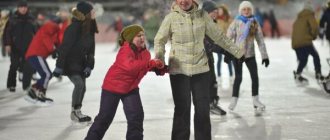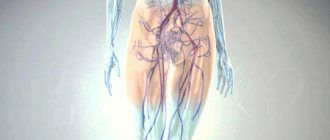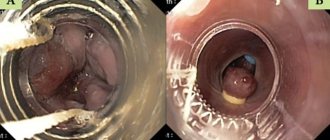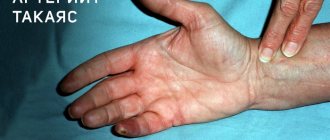Symptoms of varicose veins today are not a secret for modern people in Moscow. Many online resources on the Internet, state television, and simply complaints from friends sometimes provide comprehensive information about the symptoms of varicose veins. And there is nothing strange about this. Varicose veins of the lower extremities are one of the most common modern diseases of mankind.
Manifestations of varicose veins
According to government statistics, 10% of men and about 30% of women suffer from varicose veins. The symptoms of varicose veins in Moscow, the Moscow region, the European part of Russia and other regions of our country will be similar.
Modern phlebology identifies the following manifestations of varicose veins.
Symptoms depending on the stage of the disease
Of course, it should be noted that the stage of development of the disease, the rate of progression, and existing complications (such as decompensation of venous outflow, thrombosis, varicothrombophlebitis, trophic ulcers), which are purely individual for each patient, are of great importance. Depending on the above, the optimal treatment option is selected.
The leading symptoms of varicose veins of the lower extremities are: swelling of the legs at the end of the working day, reticular veins - visually dilated saphenous veins, telangiectasias (in colloquial language - “spider veins”). For a long time, varicose veins manifest themselves only as a cosmetic defect - the presence of reticular veins, varicose veins (varix, lat. - node), however, it should be noted that the further development of varicose veins leads to the appearance of much more formidable symptoms and complications, such as pain, swelling of the feet and legs, and in advanced stages can lead to pigmentation of the skin of the legs (usually the internal surfaces), trophic ulcers, thrombosis, and varicothrombophlebitis.
Leg pain due to varicose veins: symptoms and causes
Pain with varicose veins is not the only manifestation of this disease, but it causes serious discomfort. How severe is the pain in the legs with varicose veins? Of course, there are differences in individual sensitivity thresholds, but the intensity of most pain syndromes is determined by the characteristics of the actual pathological process.
Expert opinion
Pain in the legs with varicose veins includes a wide range of unpleasant feelings: aches, spasms, cramps, burning, distension and pressure along the venous bed. They are of a sudden nature, aching and pulsating.
Vascular surgeon, phlebologist
Osipova Ekaterina Yakovlevna
As a rule, the pain syndrome is felt less or more acutely depending on the position of the body, whether it is burdened with any load at the moment or not. Pain also has such a characteristic as time dependence. This means that with the arrival of a certain time of day, the pain syndrome begins to intensify. Thus, severe pain with varicose veins occurs starting in the second half of the day. Varicose veins of the uterus and varicose veins of the small pelvis also have a similar dependence on time, in which severe aching pain is often felt in the lower abdomen.
Stages of varicose veins
Such an insidious disease as varicose veins covers the entire limb and can create pain in the joints of the lower leg, calf muscle and popliteal cavity. A person experiences the most acute discomfort in the area where the neurovascular formations are located. In the area where the vascular bundle lies more superficially, swelling of the legs may additionally occur. This is another sign that varicose veins are progressing and there is already a violation of lymph outflow. Does leg pain get worse due to swelling? Of course yes. Swelling, formed as a result of disturbances in the venous system of the lower extremities, is characterized by compaction over the vessel affected by the pathology and even a local increase in temperature. The combination of signs such as pain in the vein and its deformation, persistent, non-subsiding swelling and trophic changes indicates stage II varicose veins. This stage is considered an advanced form of the disease. To prevent this, it is important to know the provoking factors of this vascular disease and its exact symptoms.
The presence of even one of the following symptoms should alert you and prompt you to consult a doctor:
- a feeling of heaviness in the legs and a feeling of muscle weakness;
- tingling and burning along the veins;
- a feeling of internal pressure or “bloating”;
- the appearance of telangiectasia and increased venous pattern;
- bulging deformed veins;
- trophic changes in the skin;
- long-term non-healing wounds on the legs;
- edema phenomena;
- numbness of the lower extremities;
- leg muscle cramps;
- pain syndrome.
No disease occurs on its own. There are definitely factors that can be called provoking. Varicose veins are no exception, so their appearance can be caused by:
- hereditary predisposition;
- congenital weakness of connective tissue and vascular walls;
- inactive lifestyle and static sports;
- excessive physical activity;
- forced prolonged standing or sitting (for example, at work);
- poor nutrition and excess weight;
- presence of bad habits;
- pregnancy and childbirth;
- hormonal imbalance;
- soft tissue injuries;
- surgical intervention;
- liver diseases.
Based on the presence of these factors in a person, he is included in the risk group for developing vascular pathology. How to minimize the risk of developing the disease? What can you do if you begin to experience pain in your legs? How and with what to relieve or reduce pain in the leg with varicose veins? How to help yourself alleviate the symptoms of varicose veins and how to treat blood vessels, further in our article.
Why do we need modern diagnostics even in the absence of obvious symptoms of varicose veins?
Varicose veins of the lower extremities are unique in that pain is present only in the early stages of the development of this disease, and as the walls of the veins thicken, they are reduced to almost nothing. For a long time, a person may simply not notice varicose veins. The first symptoms of serious varicose veins are pain in the calf muscles, a feeling of heaviness and burning, swelling, itching, as well as darkening and thickening of the skin of the lower leg. Thus, in advanced stages of varicose veins, the symptoms of complications of varicose veins already take the leading role in the symptoms. Therefore, a preventive visit to a good European-level phlebologist in Moscow is the best way to avoid these complications.
Diagnostics
When examining patients who have leg pain in the vein area, phlebologists pay attention to the location of the pain and the color of the skin over the vein.
If a vein appears on the leg and it hurts, an ultrasound scan is performed. Doctors use 1, 2 or 3 research modes. The main one is B-mode. Additionally, color coding of blood flow or pulsed wave Doppler, as well as a combination of both, is used. The method allows you to simultaneously examine the vein in the leg that hurts, determine the direction of blood flow and its parameters. Patients who have pain and stretching of the veins in their legs must undergo an examination of the superficial and deep veins of both lower extremities. At the Yusupov Hospital, doctors for ultrasound scanning use devices equipped with linear sensors with a frequency of 5 MHz and more from the world's leading manufacturers. To scan deep veins, especially in obese patients, convex sensors with a lower radiation frequency (from 3.5 to 5.0 MHz) are used.
Doppler ultrasound allows you to obtain sound information, which doctors use to judge the presence or absence of blood flow through the main veins. By changing the sound signals during functional tests, blood reflux (reverse discharge) is detected. During X-ray contrast venography, the phlebologist examines the deep and superficial veins. He receives comprehensive information about the morphological changes of the venous system. This research method is used when planning surgery in patients with blocked or underdeveloped veins. Phlebologists at the Yusupov Hospital use the technique of transfemoral ascending phlebography.
Radionuclide phlebography allows you to obtain data on the nature and direction of blood flow through deep, superficial and perforating veins under conditions that are as close as possible to physiological ones. The study is carried out with the patient standing while simulating walking. Radiophlebography allows for an integrative assessment of blood flow throughout the entire system simultaneously.
Intravascular ultrasound examination is carried out to determine the shape and extent of the narrowed segment of the vein when its patency is impaired after thrombosis or compression of the venous vessel from the outside. Infrared thermography, computer thermal imaging, radiothermometry are used as an additional method of studying patients whose cause of pain in the veins of the legs is chronic venous insufficiency. Using this method, the dynamics of the inflammatory process in tissues is monitored, as well as the effectiveness of therapeutic measures is assessed.
Innovative treatment of varicose veins at various stages in the center of Moscow
During the consultation, an individual treatment regimen is selected for each patient suffering from varicose veins of the lower extremities, taking into account the stage of the disease. In the early stages, medical conservative treatment with the use of medications, electromyostimulators, compression stockings and sclerotherapy is quite sufficient. Modern treatment of varicose veins in the early stages of pathology can be implemented by gluing veins. For this purpose, one of the best medical techniques used today is sclerotherapy, the essence of which is the removal of dilated veins by introducing into them special drugs, the so-called sclerosants. In advanced stages of varicose veins that are not amenable to conservative treatment, non-surgical treatment is performed ( Venefit™ RFO procedure
or EVLO
).
Treatment of symptoms of varicose veins with thermal methods in our center
These innovative techniques are currently the leading, most advanced and are used in the best phlebological centers around the world, including Moscow and the Moscow region. Good phlebologists often supplement the procedure of radiofrequency (RFO) or laser obliteration (EVLO) of the saphenous veins with miniphlebectomy and scleroobliteration using the Foam-Form method.
Leg pain due to varicose veins: prevention and treatment
Before you begin to engage in the prevention and treatment of vascular disease, it is worth understanding a little about why pain in the legs occurs with varicose veins? Pain in the legs with varicose veins occurs due to the fact that an irreversible pathological process occurs in the veins, under the influence of which they are stretched and deformed, blood circulation is disrupted and venous stagnation occurs. Therefore, both preventive measures and treatment will be aimed at strengthening the walls of the veins, and not solely at getting rid of pain. With varicose veins, the legs require special care and attention. What needs to be done when the first signs of pathology begin to appear?
!
The very first thing to do when something hurts is to consult a doctor.
If, after a series of manipulations by a specialist, it is determined that the pain is caused by varicose veins, then the appropriate treatment will be selected. It will help get rid of the manifestations of varicose veins and improve the quality of life, because varicose veins are not a death sentence.
In the treatment of absolutely any disease, the first place is the recommendation for lifestyle changes. It is simply impossible to be a healthy person with a passive lifestyle, bad habits, an imbalance in your daily routine, or poor nutrition. Therefore, the first step that will help eliminate leg pain due to varicose veins will be a qualitative change and the formation of a healthy lifestyle. It is necessary to bring harmony into the work and rest regime. Work should not involve excessive physical and mental stress. Rest should include a full, healthy night's sleep. Free time should be spent actively – spending time in the fresh air and playing sports. The latter includes swimming, race walking, and aerobics. Any non-impact and not overloaded with powerful physical activity activities.
Expert opinion
In order for the vein walls to be strong and elastic, it is important to eat properly. Here, depending on the stage of the disease and its dynamics, a specialist may suggest a therapeutic diet. The main principle on which it is built is balance. The diet should include foods enriched with vitamins, fiber, plant fibers, flavonoids, etc. It is useful to eat lean chicken or beef meat, as well as lean white fish, berries and fruits with vitamin C, dried fruits (raisins, dates), almost everything vegetables, nuts and legumes, cereals, as well as natural non-carbonated drinks. It is necessary to exclude fried, salted, smoked and spicy foods.
Vascular surgeon, phlebologist
Osipova Ekaterina Yakovlevna
If for some reason an additional source of useful substances is required, the specialist will prescribe it. “NORMAVEN®” is a complex of venotonic vitamins and plant extracts that acts simultaneously in several directions, due to the content of active natural ingredients in its composition. By taking this remedy, you can strengthen and cleanse the walls of venous vessels, improve blood circulation, and reduce capillary permeability and fragility.
Further, depending on which specialist determines the stage of the disease, it will also depend on how the disease will be treated - with a conservative or radical method.
Conservative treatment methods include:
- taking medications;
- use of external products;
- physiotherapy;
- wearing medical compression stockings.
The use of medications will stop damage to the venous bed, will keep the level of blood viscosity and the formation of blood clots under control, and will also have an antispasmodic and anti-inflammatory effect. Taking medications in combination with the use of local remedies will enhance the positive effect on the veins. You can use an ointment or cream for pain with varicose veins not only for treatment, but also for prevention purposes. The action will depend on the composition of the product. The components included in it can be both synthetic and natural. Products with a synthetic composition are used not only to eliminate swelling, fatigue and pain, but also for recovery after vein surgery. Varicose veins in its initial stages, during pregnancy or if you are at risk can be counteracted using products with natural composition. Their effectiveness is directly related to the active natural ingredients they contain. "NORMAVEN®" foot cream has a venotonic effect, which will help eliminate pain in the legs due to varicose veins. Using this cream can relieve inflammation and pain, as well as improve the appearance of the skin.
!
Therapeutic gymnastics will make an important contribution to the improvement of the venous system.
Daily physical exercise, no more difficult than morning exercises, will help eliminate the unpleasant sensations of numbness in the limbs, cramps and a feeling of heaviness. The set of exercises is selected individually, taking into account the capabilities and situation. At home, the most popular are “Bicycle”, “Scissors” and shoulder stand. In an office setting, sitting at your desk, you can also stretch your legs by simply rotating your feet, bending and straightening your fingers.
To improve blood circulation and relieve unpleasant symptoms such as swelling and pain, daily wearing of compression stockings is recommended. The type of product and the degree of its compression are selected taking into account the dynamics of the disease.
Radical therapy includes invasive and minimally invasive methods. Experts try to resort to them as a last resort, in cases where conservative treatment does not help or the situation is assessed as severe.
Take care of your health!
Why you shouldn’t delay treatment when symptoms of varicose veins appear
It should be noted that the degree of overstretching of the veins in each individual case is different, and therefore the consequences of varicose veins are not always possible to predict. Among the most common complications are thrombophlebitis, trophic ulcers, as well as bleeding and thromboembolism with irreparable consequences.
As for surgical intervention, it is usually resorted to in advanced cases. Among all the currently existing surgical techniques, modern miniphlebectomy and innovative endovasal methods of vein obliteration stand out. Much attention should be paid to the prevention of varicose veins. For this purpose, it is better to seek advice from a good phlebologist in Moscow. Do not self-medicate under any circumstances. The consequences can be very sad.
Prevention of varicose veins
There is no way to completely prevent varicose veins. But improving circulation and muscle tone can reduce the risk of developing varicose veins. Measures to treat discomfort from varicose veins at home:
- Gymnastics
- Maintaining an optimal body mass index
- High fiber, low salt diet
- Avoid high heels, tight hosiery and other tight clothing
- Leg Raising
- Change your sitting or standing position regularly
Well, it's time to move.










